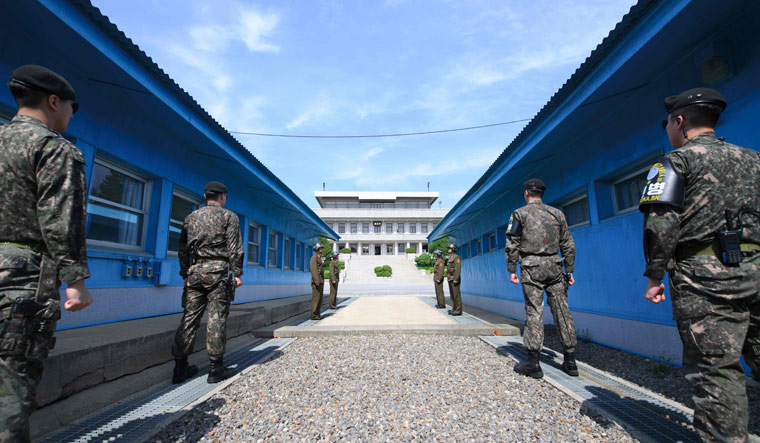It was at a rest area along Route 43, the national highway linking Sejong city in South Korea to Kosong county in the North, that we met Sergeant Allender of the US Army. A few other American soldiers were also present at the rest area, where we stopped on our way to the Demilitarised Zone. Being on official duty, none of them were ready to talk.
But, the presence of US soldiers is quite common in South Korea, especially in its north, close to the Demilitarised Zone. As many as 28,500 of them are stationed in the country. In many places, they are closely aligned to the local life and culture. Some of them teach English in local schools as well. Their presence, which started from the days of the Korean War, however, is likely to become a controversial issue if the peace process between the two Koreas proceeds as expected.
Blue House, the office of South Korean President Moon Jae-in, had to issue a clarification on this issue on May 2 after one of his advisers, Moon Chung-in, wrote a newspaper column that it would be difficult to justify the presence of US forces in South Korea if a peace treaty was signed between the two Koreas.
The president’s office publicly corrected the adviser and said the issue was not linked to any future peace treaty with North Korea. “US troops stationed in South Korea are an issue regarding the alliance between South Korea and the United States. It has nothing to do with signing peace treaties,” said Kim Eui-kyeom, a spokesman for the president. “American forces should stay even if such an agreement is signed.”
The presence of US troops and the protection offered by the US nuclear umbrella is a key element of South Korean national security. Apart from threats from North Korea, the presence of US troops is vital also in handling possible escalations with neighbouring powers like China and Japan. Meanwhile, North Korea has already indicated that it did not have any problem with US troops being present in the South. China, on the other hand, is understandably wary about a significant American presence on its doorsteps, especially if the two Koreas sign a peace agreement.
China and Japan, the two countries that feel they have been left out of the Korean peace process, are trying hard to keep up their profile, especially with the likelihood of US President Donald Trump holding a summit with North Korean Supreme leader Kim Jong-un. Japanese Prime Minister Shinzo Abe said on May 1 that Tokyo would host a trilateral summit on May 9 with Chinese Premier Li Keqiang and President Moon next week to discuss North Korea.
“We must lead the momentum to having North Korea take concrete steps toward complete denuclearisation on the Korean Peninsula," said Abe, during a visit to Amman, Jordan. Li is visiting Japan from May 8 to 11 to commemorate the 40th anniversary of the signing of a friendship treaty between the two countries.
The two Koreas, meanwhile, are going ahead swiftly on the path of reconciliation. At the DMZ, there is a great deal of excitement as South Koreans believe that this time they are truly on the road of peace.
On May 5, North Korea, will shift its time zone by 30 minutes to align itself with Southern time. And, the two countries have started dismantling loudspeakers that for decades blared propaganda to each other. North Korea broadcast messages criticising the 'depraved capitalist' South and the US and spoke of the glory of the people’s revolution in the North and the virtues of its ruling dynasty. However, the North’s broadcasts were less effective because of power outages and technical problems.
The South beamed anti-communist propaganda, and also news from the Korean peninsula and across the world as well as weather updates and Korean pop songs. With their technical know-how, South Korea managed to broadcast at least about 20km deep into North Korea.
With the Panmunjeom Peace Village being spoken of as a potential venue for the proposed summit between Kim and Trump, the entire demilitarised zone is in a state of heightened anticipation.
Roadblocks are tight and security screenings are stringent. Columns of South Korean troops can be seen marching through the countryside. There is rising hope that peace will return to the peninsula from the place where the war ended 65 years ago.


